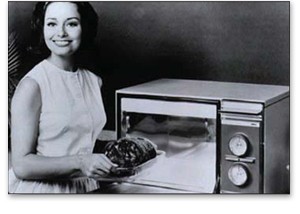Accidents Happen

The Invention of the Microwave
By Alida Cataldo
Like so many other innovations, the invention of the microwave oven wasn’t intentional. Its genesis was in a laboratory at Raytheon Company where, in 1946, Percy LeBaron Spencer was testing a tube (magnetron) that produced microwaves for Britain’s radar system. When he discovered that the chocolate candy bar in his pocket had melted, he decided to experiment.
First Spencer placed some corn kernels near the tube. Soon he had popcorn strewn all over the lab. Then he set an egg near the tube and watched a colleague get covered in yolk when the egg exploded. Spencer correctly deduced that these results were generated by exposure to low-density microwave energy. And then he wondered: Could the magnetron raise the temperature of other foods and cook them faster than a conventional oven?
Spencer built a metal box into which he could feed microwave power. The power was contained, so it created a higher density electromagnetic field. He found that foods exposed to microwave energy in the box got very hot very quickly … and the microwave oven was born.
From the Lab
Raytheon was excited about this new technology and set about designing a “real” microwave oven. When completed, the unit was 5½ feet tall, weighed more than 750 lb. and cost about $5,000. In 1947, the Raytheon “Radarange” was successfully tested in a Boston restaurant; it was available for commercial sale by 1954. Because of its size, cost and the fact that special plumbing was needed to run it, the microwave oven was relegated to restaurant and institutional use only. In 1967, Amana (a division of Raytheon) produced a countertop microwave oven for home use. Interest was tepid at first; but by 1975, microwave oven sales exceeded those of gas ranges. Today, almost every home has one.
About the Inventor
Percy LeBaron Spencer was a self-taught engineer and inventor. He didn’t finish grammar school but was educated in wireless telegraphy while serving in the U.S. Navy. Spencer joined Raytheon in the 1920s and remained there until his death at age 76. During his career, he accumulated 150 patents and was inducted into the National Inventors Hall of Fame in 1999.
Classroom Discussion
- In addition to cooking food, how else can the microwave oven be used?
- Name other “modern marvels” that were invented by accident.

